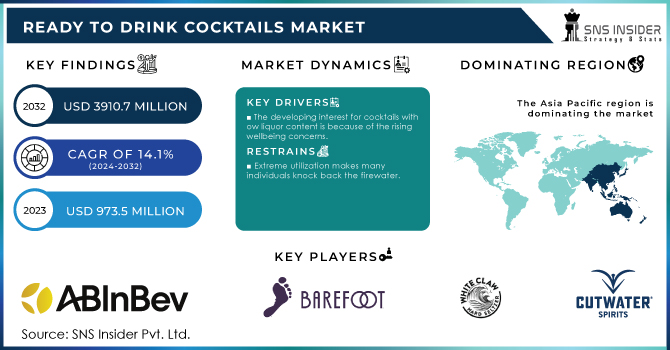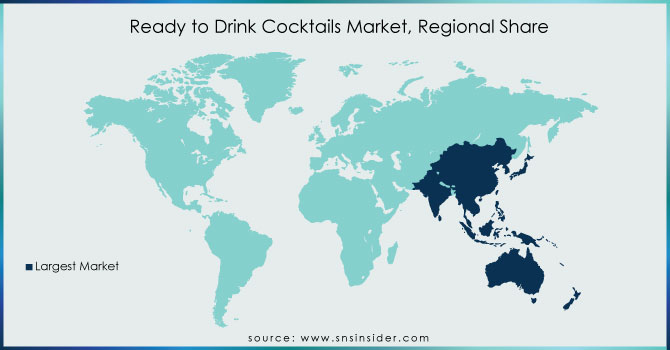Ready to Drink cocktails Market Overview:

Get more information on Oligonucleotide Synthesis Market - Request Free Sample Report
The Ready to Drink Cocktails market size was valued at USD 973.5 million in 2023 and is expected to reach USD 3910.7 million by 2032, growing at a CAGR of 14.1% over the forecast period of 2024-2032.
Ready to drink cocktails is an enhanced carbonated cocktail that contains low calories and sugars in contrast with other cocktails. Rising interest for low liquor content, low calories, and sans gluten refreshments is driving the development of the market. Moreover, expanded extra cash and generally speaking spending on cocktails are likewise adding to showcase development in the given conjecture time frame.
Ready-to-drink cocktails have acquired colossal ubiquity because of powerful web-based entertainment promotions that have offered Ready-to-drink cocktails as a "better" liquor decision. Ready-to-drink cocktails' development is likewise because of various makers entering the market and offering an enormous assortment of items and numerous item dispatches. For example, in May 2020 Kopparberg, a Swedish producer sent off a scope of Ready to drink cocktails in the U.K.
The developing interest for cocktails with low liquor content because of rising wellbeing concerns and expanding customer tendency toward Ready-to-eat and Ready to drink items inferable from occupied ways of life and chaotic plans for getting work done is driving the interest for RTD cocktails.
Market Dynamics:
Driving Factors:
-
The developing interest for cocktails with low liquor content is because of the rising wellbeing concerns.
-
Premiumization of the item with flavors, taste, quality, and bundle plan.
Restraining Factors:
-
Extreme utilization makes many individuals knock back the firewater.
Opportunity:
-
Better mindfulness is pretty much ready to drink cocktails.
-
Expansion of offering Ready to drinks through web-based channels, particularly on company and internet business sites.
Challenges:
-
Raises the risk of awful well-being results, mishaps, and wounds, also the gamble of deadly liquor harming.
Impact Of Covid-19:
The COVID-19 pandemic decidedly affects the market. However, the interest for them was at that point rising, the section detonated after the COVID-19 pandemic hit the world. The development of the at-home mixed drink culture, expanded worries for wellbeing, accommodation, and the upgraded quality and variety of Ready to drink cocktails are the variables behind the upsurge sought after.
The pandemic has made numerous purchasers change their purchasing propensities and convert to internet shopping with an end goal to keep away from openness to the infection. Moreover, with an end goal to arrive at additional buyers, physical retailers are starting to understand the significance of fostering an internet business methodology and are in this manner going to web based requesting and conveyance stages.
Market Segmentation:
By Primary Base:
-
Rum
-
Whiskey
-
Vodka
-
Wine
-
Others
By Alcohol Base:
-
Malt Based
-
Spirit Based
-
Wine Based
By Packaging Type:
-
Can
-
Bottle
-
Others
By Distribution Channel:
-
Online
-
Offline
-
Specialty Stores
-
Hypermarket/Supermarket
-
Departmental Stores
-
Others
-
By Price Category:
-
Low
-
Medium
-
High/Premium
As far as type, soul based RTD cocktails arose as the biggest fragment in 2023 and are expected to keep up with their lead in the figure period. They are well known among customers inferable from their low liquor content and the accessibility of different flavors.
The distribution channel portion is projected to keep up with its lead all through the estimate period attributable to the high buyer tendency toward shopping basic food item items from general stores and general stores, specialty stores, and supermarkets as these spots appreciate high client inclination.
At first, the Ready to drink cocktails idea was sent off in a container bundle plan and became famous around the world. As it intently looks like brew, bundling was done in glass bottles. Further, the aluminum deficiency in nations, like the U.S., has prompted the presentation of glass bottles. These market patterns expanded the interest for glass bottles across the globe.
Regional Analysis:
In light of district, the market is fragmented into North America, Europe, Asia Pacific, Latin America and Middle East and Africa (MEA). North America region is moreover bifurcated into countries like U.S., and Canada. The Europe area is additionally arranged into U.K., France, Germany, Italy, Spain, Russia, and Rest of Europe. Asia Pacific is additionally divided into China, Japan, South Korea, India, Australia, South East Asia, and Rest of Asia Pacific. Latin America locale is additionally portioned into Brazil, Mexico, and Rest of Latin America, and the MEA area is additionally partitioned into GCC, Turkey, South Africa, and Rest of MEA.

Get Customized Report as per your Business Requirement - Request For Customized Report
North America
-
USA
-
Canada
-
Mexico
-
Europe
-
Germany
-
UK
-
France
-
Italy
-
Spain
-
The Netherlands
-
Rest of Europe
Asia-pacific
-
Japan
-
South Korea
-
China
-
India
-
Australia
-
Rest of Asia-pacific
The middle east & Africa
-
Israel
-
UAE
-
South Africa
-
Rest of middle east & Africa
Latin America
-
Brazil
-
Argentina
-
Rest of Latin America
Key Players:
Anheuser-Busch InBev, Barefoot Cellars, Blue Marble, White Claw, Boathouse Beverage Co., Future Proof Brands LLC, Cutwater Spirits, Ficks & Co., High Noon Spirits Company, Lift Bridge Brewing Co.
| Report Attributes | Details |
|---|---|
| Market Size in 2023 | US$ 973.5 Million |
| Market Size by 2032 | US$ 3910.7 Million |
| CAGR | CAGR 14.1% From 2024 to 2032 |
| Base Year | 2023 |
| Forecast Period | 2024-2032 |
| Historical Data | 2020-2022 |
| Report Scope & Coverage | Market Size, Segments Analysis, Competitive Landscape, Regional Analysis, DROC & SWOT Analysis, Forecast Outlook |
| Key Segments | • by Type (Malt-based, Spirit-based, Wine-based) • by Packaging (Bottles, Cans) • by Distribution Channel (Hypermarkets/supermarkets, Online, Liquor Stores) |
| Regional Analysis/Coverage | North America (USA, Canada, Mexico), Europe (Germany, UK, France, Italy, Spain, Netherlands, Rest of Europe), Asia-Pacific (Japan, South Korea, China, India, Australia, Rest of Asia-Pacific), The Middle East & Africa (Israel, +D11UAE, South Africa, Rest of Middle East & Africa), Latin America (Brazil, Argentina, Rest of Latin America) |
| Company Profiles | Anheuser-Busch InBev, Barefoot Cellars, Blue Marble, White Claw, Boathouse Beverage Co., Future Proof Brands LLC, Cutwater Spirits, Ficks & Co., High Noon Spirits Company, Lift Bridge Brewing Co |
| Key Drivers | •The developing interest for cocktails with low liquor content is because of the rising wellbeing concerns. •Premiumization of the item with flavors, taste, quality, and bundle plan. |
| Market Opportunities | •Better mindfulness is pretty much ready to drink cocktails. |

